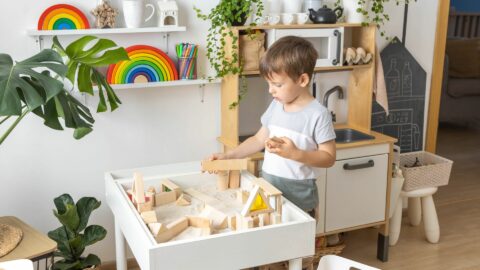As a parent, caregiver or guardian, supporting the mental health of your child is always going to be a top priority. When that child is autistic, there are some additional factors at play that you may need to be aware of.
Recognising emotions
It’s not uncommon for autistic children to have difficulty identifying and explaining their emotions. This is called Alexithymia – a Greek term that loosely translates as ‘no words for emotion’. While autism doesn’t directly cause Alexithymia, there are high rates of overlap with many autistic people experiencing this condition. This can impact their ability to form and maintain relationships and clearly communicate their own feelings and needs, which in turn can be hard for both the child and those who love them.
Recognising emotions is a skill that can sometimes be learned with practice. One way to help your child express themselves might be to use written words to represent different feelings. Emotions can bring on physical sensations, like feeling ‘buzzy’ when you are happy, or ‘hot’ when you are angry. Displaying these physical words on a wall at home can be a useful tool for your child to point out what they feel when they can’t find the right words themselves.
Managing sensory triggers
Autistic children often have sensory sensitivities, also known as sensory differences. This means they might experience a sense differently to someone else, and either be hypersensitive (over sensitive) or hyposensitive (under sensitive).
Understanding and working with your child’s sensory differences is a key part of managing their wellbeing. Figuring out their sensory needs might involve a bit of detective work to learn exactly what they like and what causes them stress or overload. For example, keeping a journal and noting down what was happening and where they were just before any moments of anxiety or overwhelm. This could give clues into what they were sensing. You might notice they often feel anxious in certain situations or after particular experiences, which could indicate a sensory sensitivity. Our Understanding different sensory sensitivities blog post provides a break-down of various behaviours and indicators for different sensitivities.
Once you identify what sensory experiences are affecting them, you can build in ways to mitigate that trigger and therefore reduce the stress it causes. Such as creating a quiet space at home with low lighting, or speaking to their school about making reasonable adjustments that caters for their particular sensitivity.
Understanding masking
Sometimes children try to hide their autistic traits to help them feel like they fit in with everyone else. This is called masking or camouflaging and might include things like covering up their special interests, hiding their stimming, or looking for tips on how to start conversations or interact with friends. They may even mimic their peers or characters from TV.
Masking can make it seem like everything is fine, but it often comes at a cost. It might mean your child is not comfortable in their own identity, or at least does not find it easy to be themselves around others. It is exhausting to constantly have to pretend, so if your child seems drained after school, socialising, family time, or being around other people, they may be camouflaging and need time to recover afterwards.
To help with this, you can celebrate their stimming (see more on this below), let them share and engage in their special interests, and talk to them about social situations. You could even create scripts and practice conversations to help them feel more comfortable around others.
Tips for supporting your child’s needs
As well as recognising different factors affecting their mental well-being, it’s helpful to have strategies to support your child’s individual needs. Below are a few tips that may help.
Create a sensory safe space
Sensory triggers can cause anxiety and stress, so your child may need to decompress after sensory stimulation. Creating somewhere for them to go, like a sensory safe space, can be really helpful. This is their personal space. It might be a favourite comfy chair, or under a weighted blanket in bed. It could also involve increasing or reducing sensory factors like lights, noise, or smells. Whatever it is, make sure the people around them know that when they go there, they need time, space, and quiet to process whatever they are thinking or feeling.
Learn their triggers
Learning to recognise your child’s emotional triggers can take some time and investigation. Do they often cry, feel ill, or start an argument after engaging in a particular activity or going to a certain place? If so, that activity or place might be a trigger. Once you identify their triggers, try to avoid them or make sure they have a sensory safe space they can go to afterwards. You could also adapt their routine if the triggers are less strong at different times of day, like early mornings or late at night.
Encourage stimming
Sensory stimulation (stimming) is something we all do, but the actions might look different in autistic people than in neurotypical people. In the allistic population it might be fiddling with your hair or tapping your knee, while in autistic people it might look more like rocking back and forth, hand flapping, or playing with fidget toys. Autistic children stim to express a range of emotions such as anxiety, happiness, joy, anger, or worry. They may also stim to give themselves time and space to process what is happening or what they are feeling. Everyone should feel free to stim as it’s vital to wellbeing. If your child feels self-conscious, you could encourage them to go somewhere private like a bathroom to stim, let them have a fidget toy concealed in their pocket, or even use dance as a way of stimming together with music.
Use emotional aids
Creating a safe space that accommodates your child’s sensory needs and where they feel safe and free to stim will go a long way to helping them express and process their emotions. Visual aids can also help them communicate their feelings. Using a traffic light system is one helpful approach. For example, you can teach your child to refer to or point to colours to indicate feelings like red for angry or confused, amber for unsettled or unsure, green for ok or happy. This can be set up as an interactive aid at home, or on a digital app or device.





